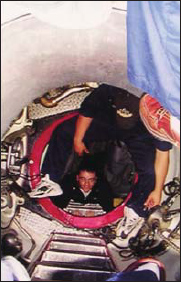
The post-World War II US submarine community was faced with two significant challenges. First was a surplus of submarines that were of a ten-year-old design. The world for which they were designed effectively ceased to exist in late 1945 – it was perceived by the general public and many in the government that there was no threat on the horizon that required a large maritime presence. These boats and the strategy that surrounded their use had been premised on cutting enemies’ lines of seaborne supply and communication. The submarine force had to find new tasks to support its continued existence. The second problem was the possibility that the Soviet Union possessed at least a dozen German Type XXI submarines and would reproduce this design or an improved design in large quantities. These boats were a distinct threat to the US Navy. Properly operated they were faster than destroyer sonar could track and could outrun a destroyer in rough seas. Thus any battle group that hoped to oppose a rapid Soviet advance into the North Atlantic or North Pacific oceans was seriously at risk.
To consider the options available for new submarines, the Office of the Chief of Naval Operations (OpNav) formed the Ship Characteristic Board (SCB) to replace the General Board for ship design. The SCB produced design requirements called characteristics and each was given a number. In addition, the SCB produced design policy documents that served as guidance for not only the design, but the fleet implementation of the design features. The SCB in 1945/46 realized that it had to redesign the fleet submarine and the new design had to be as good as, or (preferably) better than, the Type XXI U-boat. Design characteristics that the SCB wanted improved included sonar, weaponry, silencing, batteries and underwater endurance, propulsion systems, and underwater speed and control.
In the fall of 1945 Commodore Comstock, the head of the Bureau of Ships (BuShips), asked skippers and operational commanders for their views on new submarine design requirements in the areas of speed, design depth, power plants, and the effect of nuclear weapons on submarine operations and strategy. Based on the results, the design operating depth of new submarines was to be increased to 700ft, with an eye toward 1,000ft. Underwater speed would have to be increased – much of this could be attained by removing all external appendages, smoothing the hull lines, and through fairing. Model testing showed that a short submarine had better underwater performance than longer submarines.
The outcome of the initial design study was the 1947 design for the Tang Class (SCB 2). In addition to this design, in 1946 OpNav authorized an immediate experimental program that included two nuclear propulsion prototypes, four closed-cycle systems (in which the fuel and oxdizer carried onboard allowed the engines or boilers to be operated without external air), one arctic, and one midget submarine. This program was in addition to the build cycle for the Tangs. Budget restraints, however, limited the Tang schedule from six per year to two per year and put construction of the prototypes on hold because the designs were changing too fast. Then in 1950, the entire US defense budget was seriously curtailed. The submarine force struggled to have any new submarines built at all. By the time the Fiscal Year (FY) 1952 budget cycle came around, the Tang design was six years old, and a new design was needed to keep pace with the Soviets.

Down the hatch. Once a submarine is built everything that goes into the ship or comes out must pass through this vertical hatch system, the diameter of which is less than 30in. This means all stores and supplies must be handed up and down by chains of sailors. In this way the modern fast attack submarine is little different from the 18th-century sailing warship.
The Navy, using the salvaged engine room from U-1406 and a 7,500hp turbine from a German Type XXVI, tested the closed-cycle Walter system at Annapolis in 1945–47. The Walter design was the type used in the Type XXVI, and used hydrogen peroxide as an oxidant to be combined with a fuel to drive either an engine or turbine. One of the initial Tang designs envisaged using two of the turbines with the Walter system; however, this system was so large it wouldn’t fit in the proposed hull. Other alternative submarine propulsion designs were studied. These included two gas turbine semi-enclosed systems, an external combustion condensing cycle, the free-piston gas generator or gas turbine cycle, the closed-cycle diesel system, and the nuclear reactor steam propulsion system. As testing on the alternatives to diesel-electric propulsion progressed, the size of the submarine required to carry the systems grew. By 1952, therefore, the nuclear option had grown so attractive that it was adopted.
The possibility of nuclear propulsion in naval vessels had been under consideration since 1939 and under active engineering planning since 1947. Studies were undertaken to determine the best design for the propulsion plant and in August 1949 it became clear that a nuclear-powered submarine could be and should be built. The nuclear propulsion plant married a new technology with an old one. The old one was the steam turbine marine propulsion plant. This was tested, battle tested, and refined to be an efficient and lightweight (in terms of weight-to-horsepower ratio) shipboard system. The new technology was the means of generating the steam. A nuclear reactor is a means of using a controlled nuclear fission reaction to produce a desired quantity of heat energy, which in a submarine could be transferred to a boiler to generate the steam that drove the turbines. Using a nuclear reactor as a primary energy source for propulsion and electrical generation had big advantages in that the propulsion plant would not require outside air to operate, nor would it require the storage of volatile oxidants such as hydrogen peroxide.
Various experiments and engineering studies were underway to determine how best to use this heat source for power production. These centered around two areas. First was the type of nuclear fission to be used and the second was how to transfer the heat energy from the reactor core so it could be useful. Types of nuclear fission included thermal fission using enriched Uranium and fast fission with enriched Uranium, and the use of other fissile materials such as Plutonium was also considered. Heat energy transfer methods included pressurized water, pressurized gases, and liquid-metal mediums. In the end, the pressurized water thermal reactor proved to be the most attractive. The use and refinement of this system produced what has become the standard nuclear propulsion plant for surface ships and submarines.
PLATE A
The transition from the diesel-electric “fleet type” submarine to the production “nuclear fast attack” not only changed the size of submarines but produced a fundamental change in their shape. The fleet type design (1) had to compromise a good submerged performance hull form with the need to be seaworthy on the surface where it spent most of its time. The Tang Class diesel-electric fast attack design (2) smoothed much of the hull form to decrease drag. From the Nautilus design (3) was learned a great deal about high-speed submerged ship characteristics. It still retained a small superstructure for surfaced operations. The Skate Class design (4) was the first “production design” nuclear fast attack.
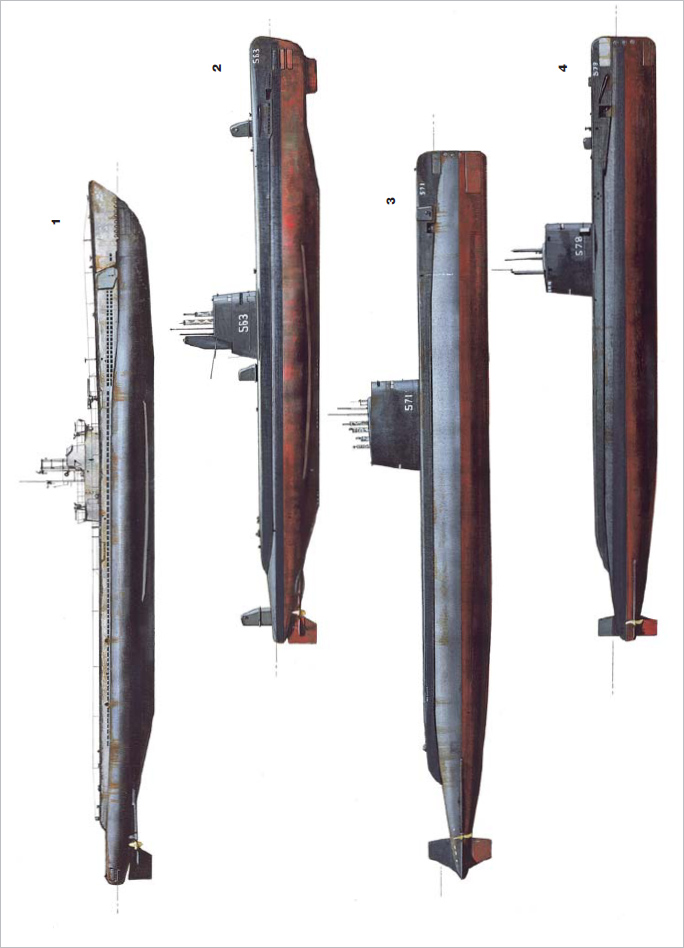
The SCB called for a specific design, SCB 64, to be part of the FY52 building program. The ship was to prove revolutionary in more than its propulsion. Its design required advances in areas that were not necessary on previous submarines. The steam plant produced a great quantity of heat that had to be controlled by increasing the size of air-conditioning systems. The ability of the boat to stay underwater for long periods of time meant that the air had to be cleansed of carbon dioxide and the oxygen replenished. Sonar performance characteristics changed because the submarine would not be making attacks while surfaced. Navigation systems had to be rethought and made independent of the standard methods that used the sun and stars for locating.
In January 1954 the world’s first nuclear-powered vessel, the USS Nautilus (SSN-571), sent a radio message “Underway on nuclear power.” The Nautilus proved that high underwater speed and long endurance were possible, and the US Navy needed to ensure it was ready for threats with the same capability. Antisubmarine warfare (ASW) tactics and strategies had to be rethought all over the world. Submarines could now travel huge distances completely out of sight and could operate unseen in any ocean. Not only did Nautilus change the future of submarines, but it also altered the future course of all naval warfare.
The USS Nautilus was a big submarine. It had three decks and plenty of internal space compared with the fleet submarine. Alongside its ability to stay completely submerged nearly indefinitely, it was fast. A Tench Class fleet submarine could run at 22 knots on the surface and a Tang Class diesel-electric could make 18 knots in a short burst or 11 knots snorkeling. Nautilus could make 23 knots while remaining completely submerged for months. It could evade destroyer screens, run in and attack escorted high-value targets, and run out again. The down-side of this speed was a very high noise level. Its ballast tank flood ports and its relatively thin plating made a humming sound that varied in frequency and intensity with speed. It has been said that the noise was so loud it prevented any conversation in the torpedo room except by shouting. Nautilus had a BQR-4 passive sonar system. The 48 vertical stave hydrophones wrapped around just inside the skin of a sonar dome that was faired into the forefoot of the boat. This sonar system was useless at any appreciable speed because of the noise created by the ship itself. However, using sprint and wait tactics, Nautilus proved to be a dangerous adversary. During one of her first tactical trials she demonstrated a greater threat than all the accompanying diesel-electric submarines combined.
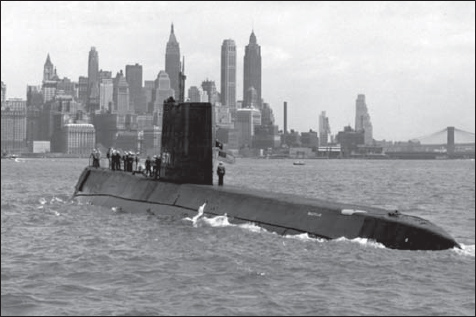
USS Nautilus makes its triumphant entry into New York Harbor after crossing from the Pacific to the Atlantic under the Arctic ice. She demonstrated in stunning fashion that the Arctic Ocean could be traversed, and opened it for submarine operations that continue to this day.
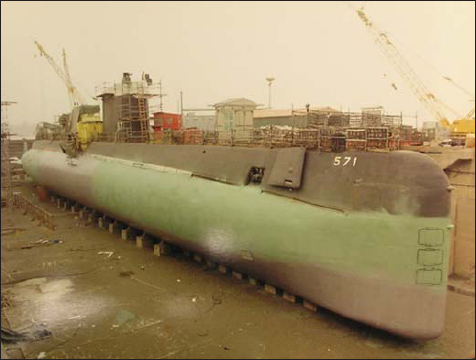
USS Nautilus in dry dock being overhauled. The BQR-4 sonar dome is clearly visible, faired into the forefoot. The bow planes are aft of the hull number and fold against the hull, as with the fleet submarines. Skate Class boats had the bow planes fold back and into slots in the forward superstructure. The green color paint is antifouling paint but is different from that used by operational submarines.
Nautilus had six torpedo tubes forward in the torpedo room. The crew and officers’ berthing and messing spaces were located aft of the torpedo room. The control room and conning stations were farther aft under her large sail (or “fin” in Royal Navy nomenclature). Just over half the ship was taken up by the reactor compartment and engine room. The reactor compartment housed the reactor, primary coolant piping, steam generators, and attendant systems. It was not a manned space and was only accessible if the reactor was shut down. Passage fore and aft took place through a narrow shielded space at the top of the reactor compartment, which came to be called “the tunnel.”
With the steam plant came a few benefits not generally available to diesel-electric boat sailors. The first was a large quantity of fresh water for cooking and personal use. Water for showers and bathing was very limited, if available at all, on diesel-electric subs. The second benefit was air conditioning. Having a steam plant in an enclosed space demanded some method of dealing with heat build-up, but a large amount of available electricity allowed for major air-conditioning plants to be installed and operated. These increased the level of habitability to a point not seen on previous boats.
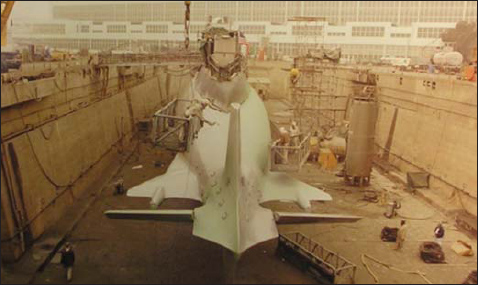
Nautilus’ stern. The propulsion shafts were faired into a fixed portion of the stern plane structure. The moveable part is seen here angled down. The fairing around the rudder and planes was not repeated. Along the side above the planes are a set of small tabbed rectangles. These are sacrificial anidodes that help control dissimilar metal corrosion.
NAUTILUS CLASS
Design designator EB251A, SCB-64
Class consists of one ship: USS Nautilus (SSN-571)
Dimensions Length 323ft 9in.; beam 27ft 9in.
Displacement (surfaced/submerged) 3,533/4,092 tons
Speed (surfaced/submerged) 23/23.3 knots
Endurance Only limited by supplies
Design test depth See author’s note
Complement (officer/enlisted) 13/92
Armament Torpedo tubes: six Mk 50 torpedo tubes (23ft long by 21in. diameter). The tubes and fire-control systems are capable of handling various types of torpedo (Mk 14-6, Mk 16-6, -8, Mk 37-1, -3).
Service history:
Laid down 14-Jun-52
Launched 21-Jan-54
Commissioned 30-Sep-54
Decommissioned 30-Mar-80
Final disposition Designated as Historic Ship Nautilus, and is the centerpiece of the Submarine Force Library and Museum in Groton, CT
A second nuclear-powered submarine was already being built when Nautilus took to the water. The USS Seawolf (SSN-575) was smaller and initially had a reactor system that used liquid sodium as a moderator and heat-transfer medium rather than water. This system, although attractive because it reduced the size of the primary plant, was deemed too difficult to maintain and was discarded after ship testing. The reactor plant was replaced with a pressurized water plant.
A production model of a nuclear submarine was on the drawing board at the time. This, a Skate Class, would be smaller than Nautilus and Seawolf but incorporated some of the lessons learned from initial operations of Nautilus. These three classes (Nautilus, Seawolf, Skate) held on to many of the design features of the diesel-electric fleet submarines. The hull shape was similar to the Tang Class to keep some form of surfaced seakeeping. The propulsion system had twin screws to provide redundant power – if one screw or one side of the engine room were to become damaged, the ship could still maneuver and travel with the other screw.
Much smaller and somewhat more crowded than Nautilus, the Skates proved to be exceptionally useful. The reactor compartment and engine rooms were smaller and more compact. The boats were slower than Nautilus but their submerged endurance still allowed them freedom of operation that diesel-electrics could not match. The operations compartment and torpedo rooms were rearranged to provide more efficiency in conning and combat management. Following the lead of Nautilus, USS Skate transited submerged in the Arctic, but, going one better, she surfaced at the North Pole. USS Seadragon (SSN-584) completed the transit in a reverse manner, from the Atlantic to the Pacific.
SKATE CLASS
Design designator EB264A
Class consists of four ships: USS Skate, USS Sargo, USS Swordfish, and USS Seadragon
Dimensions Length 267ft 8in.; beam 25ft
Displacement (surfaced/submerged) 2,550/2,848 tons
Speed (surfaced/submerged) See author’s note
Endurance Only limited by supplies
Design test depth See author’s note
Complement (officer/enlisted) 8/76
Armament Torpedo tubes: six Mk 56 forward (23ft long by 21in. diameter); two Mk 57 aft (18ft long by 21in. diameter). The tubes and fire-control systems are capable of handling various types of torpedo (Mk 14-6, Mk 16-6, -8, Mk 37-1, -3), the longer torpedoes from the forward tubes only.
Service history:
| Laid down | Launched | Commissioned | Decommissioned | |
| USS Skate (SSN-578) | 21-Jul-55 | 16-May-57 | 23-Dec-57 | 12-Sep-86 |
| USS Swordfish (SSN-579) | 25-Jan-56 | 27-Aug-57 | 15-Sep-58 | 2-Jun-89 |
| USS Sargo (SSN-583) | 21-Feb-56 | 10-Oct-57 | 1-Oct-58 | 26-Feb-88 |
| USS Seadragon (SSN-584) | 20-Jun-56 | 16-Aug-58 | 5-Dec-59 | 12-Jun-84 |
| All these ships have been disposed of by the SRP. | ||||
As the design cycle for the Skate Class was coming to a close and all the boats of the class were either built or being built, the Navy was looking at making another profound change in submarine design. Back in 1900 John Phillip Holland in his Design #6, which was to become the USS Holland (SS-1), created a hull form for underwater travel. It had a screw aft of the rudder, stern planes, and a minimal superstructure. During its sea trials, Holland found that a submarine with a single screw and the rudder forward of the screw was nearly unmanageable at slow speed (slow was his only real choice of speed). This lesson was relearned by the Navy 60 years later. However, the hull form was adopted and studied in the experimental submarine Albacore and the three diesel-electric submarines Barbel, Bonefish, and Blueback.
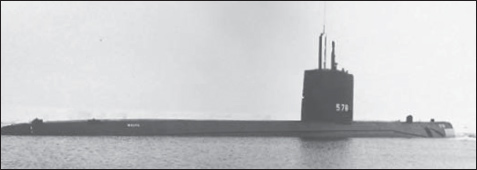
The USS Skate became the first vessel in history to surface at the North Pole. During her visit, in March 1959, the crew held a memorial service and scattered the ashes of the famed explorer Sir Hubert Wilkins, who had died the previous November. Sir Hubert had refitted an O Class US submarine to explore under the Arctic ice in 1931. His expedition reached the ice pack and briefly dove under, proving it was indeed possible. The submarine he used, which he had renamed the Nautilus, was scuttled in a fjord near Bergen, Norway, where it remains to this day.
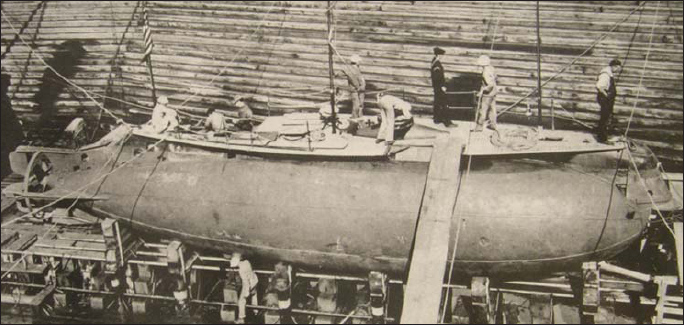
The USS Holland, first of the commissioned submarines in the US Navy, shows the hull form adopted nearly 60 years later for efficient underwater performance.
The shift to a single screw was not popular with everyone but it was shown that to maximize the underwater speed of a submarine with a given shp, a “cylinder of revolution” teardrop hull form with a relatively low length-to-beam ratio was desirable. The new class of submarine, which matched an upgraded and somewhat larger nuclear powerplant with the new hull form, was the Skipjack Class. Here was a submarine that approached what we know of today as nuclear fast attack capability. The short, “fat” hull shape combined with a smooth outer surface, made the boat very fast indeed, with a speed of over 25 knots (it was even faster than the design group had hoped.) Skipjack also had a smaller superstructure than the Skate, thus had less hydrodynamic resistance even though it had a larger volume. It was shorter than Nautilus but had a more efficient use of internal volume.
The sail on the Skipjack Class was enormous. This gave it good seakeeping ability at periscope depth because of the vertical separation between the top of the sail (from which her masts, periscopes, and antenna protruded) and the top of the pressure hull. The forward hydroplanes were moved from their normal position near the bow, cutting down on the amount of flow noise affecting the bow-mounted sonar arrays. The shape and smoothness of the hull made the sonar, still the venerable BQR-4B, more effective at a higher speed, but the machinery noise remained a serious problem. The sail had a small “turtleback” that ran from the lower trailing edge nearly to the engine-room hatch. This housed the emergency diesel exhaust piping, which couldn’t be run through the reactor compartment. The large sail, this turtleback, and the short fat hull made the Skipjacks very identifiable.
The Skipjack Class was a long-lived one and was very comfortable for the crew. A relatively large torpedo room allowed for additional crew berthing, and the crew and officer messing spaces were comfortably large. The engineering spaces were divided into the engine room and a large auxiliary machinery space between the engine room and reactor compartment. Much of the electrical distribution switchgear and switchboards, along with the electronics for reactor control and instrumentation, was situated in the auxiliary machinery space. This arrangement moved the electrical and electronic equipment away from the steamplant spaces proper to allow a more controlled (dry and oil-free) atmosphere, thus enhancing reliability.

Mr Morton Gertler, a naval architect, is shown with Mr Carson W. Caudle with a model of the USS Albacore. This model was tested at the David Taylor Ship Test Facility and showed that the streamlined hull was the shape of the future. Note the similarities between this and the USS Holland, designed and built 50 years earlier.
SKIPJACK CLASS
Design designator EB269A
Class consisted of six ships: USS Skipjack, USS Scamp, USS Scorpion, USS Sculpin,
USS Shark, and USS Snook
Dimensions Length 251ft 9in.; beam 31ft 9in.
Displacement (surfaced/submerged) 3,070/3,500 tons
Speed (surfaced/submerged) See author’s note
Endurance Only limited by supplies
Design test depth See author’s note
Complement (officer/enlisted) 9/76
Armament Torpedo tubes: six Mk 59 (23ft long by 21in. diameter). The tubes and fire-control systems were capable of handling various types of torpedo (Mk 14-6, Mk 16-6, -8, Mk 37-1, -3).
Service history:
| Laid down | Launched | Commissioned | Decommissioned | |
| USS Skipjack (SSN-585) | 29-May-56 | 26-May-58 | 15-Apr-59 | 19-Apr-90 |
| USS Scamp (SSN-588) | 23-Jan-59 | 8-Oct-60 | 5-Jun-61 | 28-Apr-88 |
| USS Scorpion (SSN-589) | 20-Aug-58 | 19-Dec-59 | 29-Jul-60 | LOST 21-May-68 |
| USS Sculpin (SSN-590) | 3-Feb-58 | 31-Mar-60 | 1-Jun-61 | 3-Aug-90 |
| USS Shark (SSN-591) | 24-Feb-58 | 16-Mar-60 | 9-Feb-61 | 15-Sep-90 |
| USS Snook (SSN-592) | 7-Apr-58 | 31-Oct-60 | 24-Oct-61 | 16-Oct-86 |
| All these ships have been disposed of by the SRP. | ||||
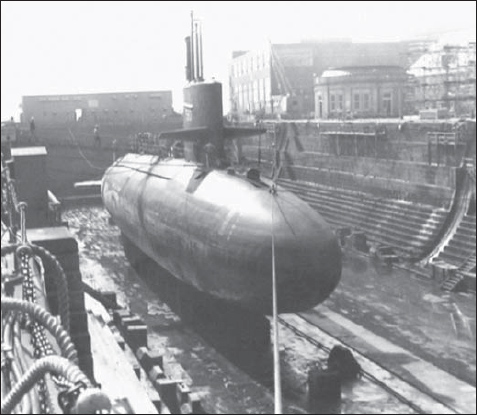
A Barbel Class submarine in dry dock. The feasibility of the hull shape for modern submarine use was proven by the experimental submarine the USS Albacore and became the standard for all modern nuclear submarines. Note also the forward hydroplanes which were moved from the bow to the sail in this class.
Halfway through the Skipjack Class design cycle, about 1957, a new submarine design went to the drawing board. It was to become the Thresher Class. This was the first of the true fast attack submarines. It had an improved sonar concept with a 16ft spherical array in the bow. The torpedo tubes were moved aft and slanted outward. The hull form as designed was going to be slower than Skipjack because it used the same powerplant on a larger hull, so other changes were made to increase speed. The sail was made smaller and thinner with the sacrifice of some periscope depth controlability and the type and number of sensor masts.
One of the main reasons for the enlarged hull was noise quieting. To complement the increased sonar capabilities, the new class had to be fast and quiet. Submarine quieting is an engineering problem that is simple in concept and extremely difficult in execution. Conceptually, sound consists of three elements: a noise source, a receiver, and a transmission path between the source and the receiver. In the case of submarine silencing, the receiver is the enemy’s sonar. The transmission path consists of everything between the noise generation source and the sonar – this includes the equipment foundation, any intermediate structure, the hull, and the external water column. The amount of noise that reaches the enemy sonar depends on the amount of noise the source generates, the directness and efficiency of the structure-borne noise paths, and the trans-missibility of the water column. As the enemy’s sonar becomes more effective (able to detect and analyze a lower level noise signal), it is able to detect a given noise source level at greater distances. To defeat this detection ability, the submarine must lower the noise source level and/or interrupt the structure-borne transmission path.
PLATE B
A fundamental change in submarine shape took place, as shown here, when the hull form took on what is known as a “body of revolution,” meaning that each hull section was a circle and the center of each circle was on the same centerline. The Barbel Class (1) was an attempt to produce a diesel-electric fast attack with good underwater performance. It still suffered from a lack of range when completely submerged. The Skipjack Class (2) was far and away the fastest submarine in the world until the Los Angeles Class. Below the Skipjack is the Thresher/Permit Class (3) which had the same power plant as Skipjack but in a slightly larger hull. Although somewhat slower than Skipjack, it was quieter and is called by many the first true nuclear fast attack class. At the bottom is the Sturgeon Class (4). Bigger than the Thresher/Permit it had a robustness and versatility that set the standard for performance and usefulness.
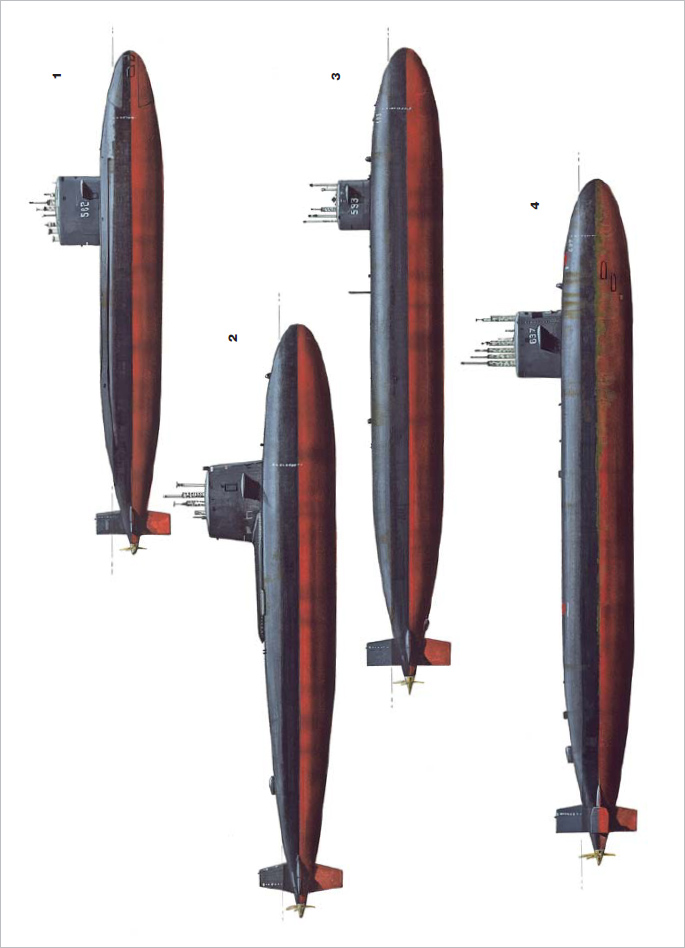
Most of the noise a submarine generates comes from rotating machinery within the hull – pumps, motors, fans, and so on. To make them quieter is feasible but expensive. Equipment must be maintained with great care. Each noise producer must be designed to be as quiet as possible. Now comes the hard part. Each noise producer must be separated from the hull by noise isolation devices commonly called sound mounts. Attention to detail is the key here. Not only must the small equipment be sound mounted, reducing noises such as flow noise in piping, transformer hum, and so on, but also the largest items such as the main propulsion turbines and turbine generators. Naval architects used the British rafting design for major equipment in the engine room. To complicate matters still further any single hard, non-isolated connection between a noise source and the hull could defeat the entire program. Such a connection is called a sound short. It takes a great deal of design work and care in construction to create a noise-quieted submarine and even more detailed maintenance and operational care by the crew and any overhaul shipyards to keep the boat quiet. In addition, it means the submarine needs to be a bit bigger than one in which there is no silencing.

Skipjack Class from the bow. Note the distance from the sail planes to the top of the sail and compare this with the photo of Thresher. The Skipjack Class was much easier to handle at periscope depth than the Thresher Class.
The first ship of the Thresher Class was the USS Thresher. It was commissioned in August 1961 and spent much of its early life in “first of class” testing. On April 10, 1963, while undergoing routine testing after a period of routine shipyard work, she was lost with all hands and a large contingent of shipyard engineers and test technicians. The loss sent ripples throughout the submarine community and not only for its loss – if there was a design flaw, it was being duplicated in the other Thresher Class boats being built and planned. The boat lay in 8,300ft of water off the coast of Maine and was not available for detailed inspection. What followed was a serious look at how the submarine force ensured quality of maintenance and material, and the result was the SubSafe Program. Everything that touches or is connected to the hull and every system or device is rigorously quality-controlled and/or pressure tested through the SubSafe Program.
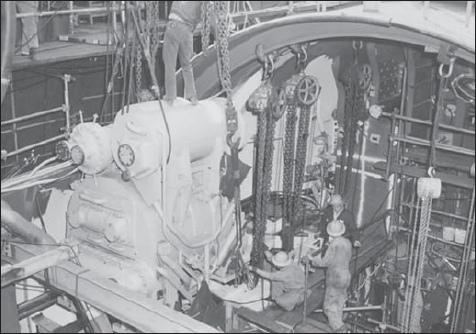
An air-conditioning unit is lowered into the hull of the boat during the construction of a Permit Class submarine. The use of a steam plant in a closed submarine hull demanded the use of significant air conditioning to deal with the heat. Note the internal hull frames in this single hull portion of the submarine.
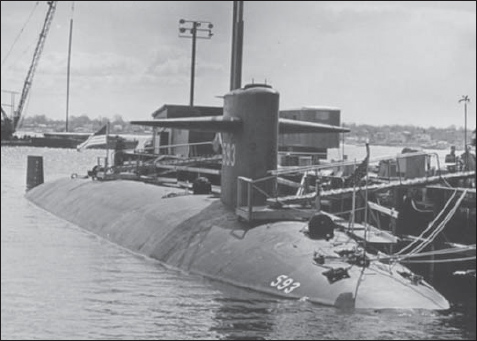
USS Thresher. This photo shows the shortness of the sail and the short distance between the sail planes and the top of the sail.
The class name was changed after Thresher’s loss – it became the Permit Class. Even though the class was longer than the Skipjacks, it seemed to be – at least to the author, who was stationed aboard both Skipjack Class (USS Scamp) and Permit Class (USS Dace) vessels – to be more crowded and less efficiently laid out. There were increased amounts of equipment aboard and increased space taken up by noise quieting efforts. The torpedo room was rearranged and moved aft and to the lower level of the operations compartment. This move was motivated by the placement of the new sonar system, which had as its central sensor a passive array on a 16ft steel sphere mounted just outside the pressure hull in the bow. The large array could “listen” up and down through a wide arc and side to side through nearly 270 degrees. Its inboard electronics were an analog system designated as the BQR-6A and integrated with a set of Passive Underwater Firecontrol Feasibility Study (PUFFS) collinearly aligned planar arrays (BQG-4). The collection of sonar sensors was generally called the BQQ-1. The complexity of the system and that of its hydrophone selection and switching system led to a high failure rate and increased maintenance over older, less-complicated systems. As the class became older, the BQQ-5 was backfitted onto many of the boats, increasing their sonar capability.
The lower, thinner sail on the Permit Class gave reduced drag, but was operationally more limited because of less space for periscopes and masts. Its height also meant more difficult seakeeping at periscope depth. The periscope was sited aft of the snorkel mast, a location that limited visibility while the submarine was ventilating and snorkeling. The emergency diesel generator was moved forward and hence eliminated the distinctive turtleback seen on Skipjacks.
As the SubSafe Program took hold, the space required to implement the elements of the program increased. Some portions of the system required new equipment and piping. For example, air dryers were required on the high-pressure side of the air compressors to ensure the 3,000psi air system, which was used for, amongst other things, blowing ballast tanks, was free from moisture which could form ice in valves and pressure reducers. One of the possible problems encountered by Thresher, proven later by testing similarly designed systems, was that moisture in the air tended to freeze in ballast blow hull valves. This would not be a problem unless the boat needed to blow a second time soon after the initial blow, as Thresher had to do. In addition, the entire high-pressure emergency ballast tank blow system had to be redesigned, and the reengineering required the use of a new, larger piping system and electrically operated blow valves. Engineering-space hydraulics and valve placement had to be redesigned to antennae with the requirement that all hull valves could be closed from a central location (the maneuvering room) and a very few local positions. Some of the Permits were lengthened, but the new requirements and new equipment actually required a new submarine design.
THRESHER/PERMIT CLASS
Design designator SCB 166A
Class consists of 15 ships starting with USS Thresher and ending with USS Haddock
Dimensions Length 278ft 6in. (see remarks); beam 31ft 9in.
Displacement (surfaced/submerged) 3,070/3,500 tons
Speed (surfaced/submerged) See author’s note
Endurance Only limited by supplies
Design test depth See author’s note
Complement (officer/enlisted) 9/76
Armament Torpedo tubes: four Mk 63 (23ft long by 21in. diameter). The tubes and fire-control systems are capable of handling various types of torpedo: Mk 16, Mk 37 Mod 3, Mk 48, Mk 48 ADCAP. In addition they carried the SubRoc (Submarine Rocket) and in later years the Harpoon antiship missile.
Remarks Ship class designation was changed to Permit Class after the loss of USS Thresher on April 10, 1963. There were various lengths and sail heights within this class. SSN-593, 594, 595, 596, 603, 604, 606, 607, 612, and 621 were 278ft 6in. long, SSN-605 was 297ft 4in. long, and SSN-613, 614, and 615 were 292ft 3in. long. USS Jack was significantly different, having a different main propulsion turbine arrangement with counter-rotating screws, but it is included in this class.
Service history:
| Laid down | Launched | Commissioned | Decommissioned | |
| USS Thresher (SSN-593) | 28-May-58 | 9-Jul-60 | 3-Aug-61 | LOST 10-Apr-63 |
| USS Permit (SSN-594) | 16-Jul-59 | 1-Jul-61 | 29-May-62 | 23-Jul-91 |
| USS Plunger (SSN-595) | 2-Mar-60 | 9-Dec-61 | 21-Nov-62 | 3-Jan-90 |
| USS Barb (SSN-596) | 9-Nov-59 | 12-Feb-62 | 24-Aug-63 | 20-Dec-89 |
| USS Tullibee (SSN-597) | 26-May-58 | 27-Apr-60 | 9-Nov-60 | 25-Jun-88 |
| USS Pollack (SSN-603) | 14-Mar-60 | 17-Mar-62 | 26-May-64 | 1-Mar-89 |
| USS Haddo (SSN-604) | 9-Sep-60 | 18-Aug-62 | 16-Dec-64 | 12-Jun-91 |
| USS Jack (SSN-605) | 16-Sep-60 | 24-Apr-63 | 31-Mar-67 | 11-Jul-90 |
| USS Tinosa (SSN-606) | 24-Nov-59 | 9-Dec-61 | 17-Oct-64 | 15-Jan-92 |
| USS Dace (SSN-607) | 6-Jun-60 | 18-Aug-62 | 4-Apr-64 | 2-Dec-88 |
| USS Guardfish (SSN-612) | 13-Feb-61 | 15-May-65 | 20-Dec-66 | 4-Feb-92 |
| USS Flasher (SSN-613) | 14-Apr-61 | 22-Jun-63 | 22-Jul-66 | 14-Sep-92 |
| USS Greenling (SSN-614) | 15-Aug-61 | 4-Apr-64 | 3-Nov-67 | 18-Apr-94 |
| USS Gato (SSN-615) | 15-Dec-61 | 14-May-64 | 25-Jan-68 | 25-Apr-96 |
| USS Haddock (SSN-621) | 24-Apr-61 | 21-May-66 | 22-Dec-67 | 7-Apr-93 |
| All these ships have been disposed of by the SRP. | ||||
The new design, which became the Sturgeon Class, had a hull that was 292ft long, a gain of just over 13ft, and the sail size was significantly increased. The Permits, due to their increased length over the Skipjacks, were nearly 3 knots slower. The Sturgeon Class was longer still and had the same power plant, so was in turn nearly 3 knots slower than the Permits. However, it had SubSafe from the start and was also much quieter. The design benefited from lessons learnt from the late Permits about equipment arrangements, and Sturgeon Class vessels were viewed by their crews to be comfortable boats. In fact, more than one crewman remembered an unofficial motto of the class as being “Give me heaven or a 637.” They were considered by most who sailed them to be the ultimate fast attack submarines. They were capable, versatile, and comfortable and they made hard, long deployments. It was not unknown for some to spend 300 days out of home port in a year. Underway times between port calls could be as long as 90 days and these boats could load stores and be back underway in as little as 24 hours.
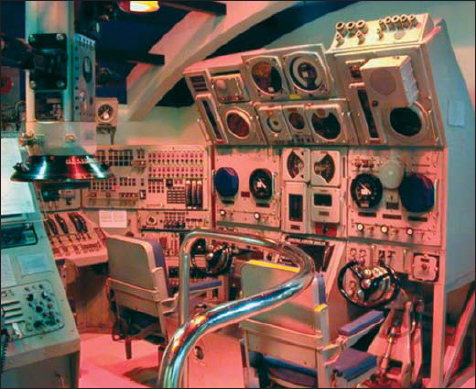
The consoles of the control center for controlling the movement of a Sturgeon Class boat underwater. The two seats are for the helm, bow (or fairwater) planes, and stern plane operators. The far console is the Ballast Control Panel (BCP). The operator there controlled the trim of the submarine and pumped water in and out to control the buoyancy. This picture is of the Ship Control Center which was on display at the Smithsonian Institution Museum of American History in Washington, DC. (Smithsonian Institution: National Museum of American History)
STURGEON CLASS
Design designator EB293A
Class consists of 38 ships from USS Sturgeon to USS Richard B. Russell. However, the hull numbers are not sequential due to the SSBN-640 Class and two “one-off” exceptions. Therefore included in the class are SSN-637, 638, 639, 646 through 653, 660 through 670, 672 through 684, 686 and 687.
Dimensions Length 292ft; beam 31ft 9in.
Displacement (surfaced/submerged) 4,229/4,762 tons
Speed (surfaced/submerged) See author’s note
Endurance Only limited by supplies
Design test depth See author’s note
Complement (officer/enlisted) 12/95
Armament: Torpedo tubes: four Mk 67 (23ft long by 21in. diameter), angled outward from midships. Bow contained sonar spherical array. The tubes and fire-control systems were capable of handling various types of torpedo (Mk 37-3, Mk 37 NTS, Mk 48, Mk 48 ADCAP), SubRoc, Harpoon, and Tomahawk missiles.
Service history:
| Laid down | Launched | Commissioned | Decommissioned | |
| USS Sturgeon (SSN-637) | 10-Aug-63 | 26-Feb-66 | 3-Mar-67 | 1-Aug-94 |
| USS Whale (SSN-638) | 27-May-64 | 14-Oct-66 | 12-Oct-68 | 25-Jun-96 |
| USS Tautog (SSN-639) | 27-Jan-64 | 15-Apr-67 | 17-Aug-68 | 31-Mar-97 |
| USS Grayling (SSN-646) | 12-May-64 | 22-Jun-67 | 11-Oct-69 | 18-Jul-97 |
| USS Pogy (SSN-647) | 4-May-64 | 3-Jun-67 | 15-May-71 | 11-Jun-99 |
| USS Aspro (SSN-648) | 23-Nov-64 | 29-Nov-67 | 20-Feb-69 | 31-Mar-95 |
| USS Sunfish (SSN-649) | 15-Jan-65 | 14-Oct-66 | 15-Mar-69 | 31-Mar-97 |
| USS Pargo (SSN-650) | 3-Jun-64 | 17-Sep-66 | 5-Jan-68 | 14-Apr-95 |
| USS Queenfish (SSN-651) | 11-May-64 | 25-Feb-66 | 6-Dec-66 | 14-Apr-92 |
| USS Puffer (SSN-652) | 8-Feb-65 | 30-Mar-68 | 9-Aug-69 | 12-Jul-96 |
| USS Ray (SSN-653) | 4-Jan-65 | 21-Jun-66 | 12-Apr-67 | 16-Mar-93 |
| USS Sand Lance (SSN-660) | 15-Jan-65 | 11-Nov-69 | 25-Sep-71 | 7-Aug-98 |
| USS Lapon (SSN-661) | 26-Jul-65 | 16-Dec-66 | 14-Dec-67 | 8-Aug-92 |
| USS Gurnard (SSN-662) | 22-Dec-64 | 20-May-67 | 6-Dec-68 | 28-Apr-95 |
| USS Hammerhead (SSN-663) | 29-Nov-65 | 14-Apr-67 | 28-Jun-68 | 5-Apr-95 |
| USS Sea Devil (SSN-664) | 12-Apr-65 | 5-Oct-67 | 30-Jan-69 | 16-Oct-91 |
| USS Guitarro (SSN-665) | 9-Dec-65 | 27-Jul-68 | 9-Sep-72 | 29-May-92 |
| USS Hawkbill (SSN-666) | 12-Sep-66 | 12-Apr-69 | 4-Feb-71 | 15-Mar-00 |
| USS Bergall (SSN-667) | 16-Apr-66 | 17-Feb-68 | 13-Jun-69 | 6-Jun-97 |
| USS Spadefish (SSN-668) | 21-Dec-66 | 15-May-68 | 14-Aug-69 | 11-Apr-97 |
| USS Seahorse (SSN-669) | 13-Aug-66 | 15-Jun-68 | 19-Sep-69 | 17-Aug-95 |
| USS Finback (SSN-670) | 26-Jun-67 | 7-Dec-68 | 4-Feb-70 | 28-Mar-97 |
| USS Narwhal (SSN-671) | 17-Jan-66 | 9-Sep-67 | 12-Jul-69 | 1-Jul-99 |
| USS Pintado (SSN-672) | 27-Oct-67 | 16-Aug-69 | 11-Sep-71 | 26-Feb-98 |
| USS Flying Fish (SSN-673) | 30-Jun-67 | 17-May-69 | 29-Apr-70 | 16-May-96 |
| USS Trepang (SSN-674) | 28-Oct-67 | 27-Sep-69 | 14-Aug-70 | 1-Jun-99 |
| USS Bluefish (SSN-675) | 13-Mar-68 | 10-Jan-70 | 8-Jan-71 | 31-May-96 |
| USS Billfish (SSN-676) | 20-Sep-68 | 1-May-70 | 12-Mar-71 | 1-Jul-99 |
| USS Drum (SSN-677) | 20-Aug-68 | 23-May-70 | 15-Apr-72 | 30-Oct-95 |
| USS Archerfish (SSN-678) | 19-Jun-69 | 16-Jan-71 | 17-Dec-71 | 31-Mar-98 |
| USS Silversides (SSN-679) | 28-Nov-69 | 4-Jun-71 | 5-May-72 | 21-Jul-94 |
| USS William H. Bates (SSN-680) | 4-Aug-69 | 11-Dec-71 | 5-May-73 | 11-Feb-00 |
| USS Batfish (SSN-681) | 9-Feb-70 | 9-Oct-71 | 1-Sep-72 | 17-Mar-99 |
| USS Tunny (SSN-682) | 22-May-70 | 10-Jun-72 | 26-Jan-74 | 13-Mar-98 |
| USS Parche (SSN-683) | 10-Dec-70 | 13-Jan-73 | 17-Aug-74 | 18-Jul-05 |
| USS Cavalla (SSN-684) | 23-May-70 | 19-Feb-72 | 9-Feb-73 | 30-Mar-98 |
| USS L. Mendel Rivers (SSN-686) | 26-Jun-71 | 2-Jun-73 | 1-Feb-75 | 10-May-01 |
| USS Richard B. Russell (SSN-687) | 19-Oct-71 | 12-Jan-74 | 16-Aug-75 | 24-Jun-94 |
| All these ships have been disposed of by the SRP. | ||||
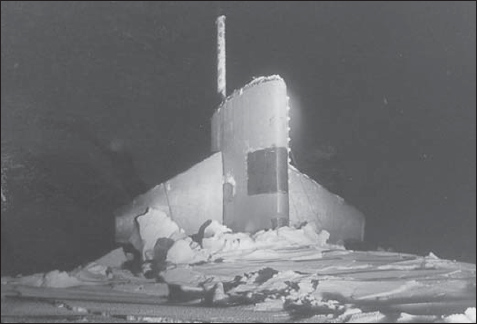
The Sturgeons were able to rotate their fairwater planes 90 degrees and had a hardened sail top. This made it possible to break through a significant thickness of ice. The dark portion of the sail front is the sound-transparent cover over the upward-looking sonar receiver.
In the late 1960s it was obvious to naval planners that the Soviets were in the midst of a submarine construction program of their own, one that included a serious requirement for high speed. The trend in US submarines, however, seemed to be toward slower boats. The Soviet Union was building fast boats that would dive deeper than the existing US vessels, hence a new design was needed that would fulfill three main objectives: dive deep, be fast, and be quiet at high speed. The design process, however, was to be difficult.
Naval Sea Systems Command (NavSea), which replaced BuShips, started the design cycle in 1966 for a fast submarine to replace the Sturgeon and Permit classes as they reached the end of their useful lives. This new submarine would have to be proficient in five mission types. They were:
Forward area – operations in the waters close to enemy bases.
Trailing – operations in which the boat had to acquire contact with an enemy vessel and follow it undetected. Enemy vessels were to include, but were not limited to, enemy ballistic missile submarines.
Direct support of battle groups – operations as part of a defensive screen.
Attacks on enemy submarines and surface ships.
Surveillance – special operations (SEAL team deployment), training etc.
The new design would not simply be an upgrade from the existing Sturgeon, it would be a whole new submarine with a new, more capable powerplant.
US Naval nuclear powerplants are designated by a letter/number combination. First is a letter S, D, or A. The letter S means a submarine plant, D is for surface craft such as destroyers and cruisers, and A is for aircraft carriers. The number starts with 1 and proceeds upward with newer plants, and the final letter, C, W, or G is for the manufacturer – Combustion Engineering, Westinghouse, and General Electric respectively. The Skipjacks, Permits, and Sturgeons used an excellent design that became a true workhorse, the S5W plant. NavSea wanted to marry a submarine version of the more powerful D1G with a new front end. Another option would be an up-powered S5G natural circulation plant that was being proven on USS Narwhal.
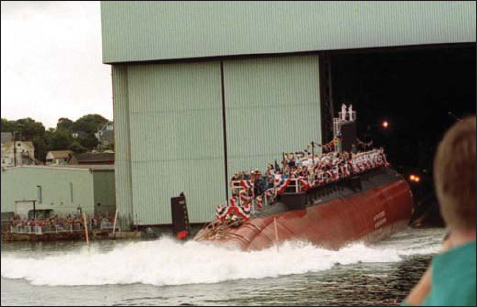
The USS Columbia was the penultimate Los Angeles Class submarine to be built and the last “slider” – that is, she slid down the inclined building ways into the water like countless ships before her. All US submarines built after her are built in level building facilities and floated into a graving dock for launch.
The Navy had to follow a new set of rules about selecting ship design. Robert McNamara was the new Secretary of Defense and his business background at Ford led him to institute a complex design process called CONFORM (Concept Formulation). This system called for a detailed study of all possible combinations of existing and future technologies and needs. Such design studies took time and cost money. Also, the CONFORM studies were in addition to the standard engineering work that had to be done just to write the specifications for the new submarine design. The CONFORM process came at a time when it seemed imperative that the United States produce a fast submarine design and build them quickly, so the two requirements were in conflict.
The actual work started with a pre-design trade-off study and the CONFORM study began in late 1968. Trade-off studies assess the best balance of engine power/ship size/armament for the most efficiently balanced design. A completely new all-digital sonar and fire-control system was specified in 1966 and would have to be included. A new propulsion plant would have to go through the CONFORM process – it could not simply be chosen by the Nuclear Propulsion Directorate – and the process had to be completed in its entirety before a new submarine design specification could be written. The new submarine design became bogged down in administration, but McNamara subsequently left and the new Secretary of Defense, Clark Clifford, scrapped the CONFORM system altogether. Fresh design specifications rapidly emerged. The new boats would be 360ft long with a beam of 33ft. The reactor plant, newly designated S6G, had sufficient shp to give a design speed in excess of 30 knots, which was faster than the Skipjacks. These boats, which were nearly as large as World War II light cruisers, would be named after US cities under the umbrella of the Los Angeles Class.
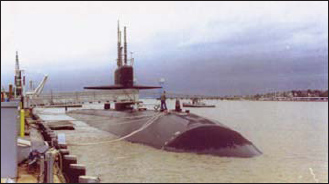
An early Los Angeles Class. The darker portion in the foreground is the fiberglass sonar dome. The lighter part is the smooth hull reflecting ambient light and the darker upper deck has grit-laden non-skid paint. The light circular object is the mooring line properly flemished down. The two masts raised highest are the BRA-34 multipurpose antennae.
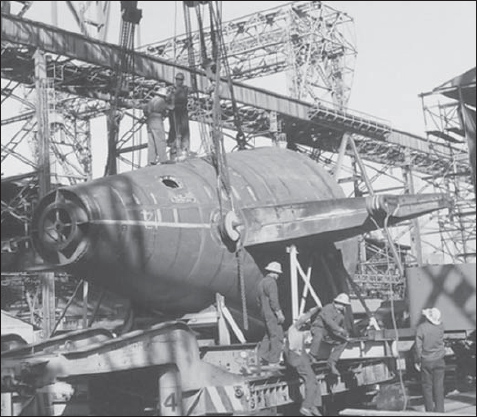
The stern cone of a fast attack submarine is prepared to be lifted off the transporter. Protruding to the right is the fixed portion of the stern planes. At the left is the opening for the stern tube through which the propeller shaft will extend.
The Los Angeles Class is quieter at speed than any other submarine to date, and the S6G powerplant has fulfilled the design speed of more than 30 knots. The sonar sphere is placed well forward and the dome wrapped around it is of sound-transparent fiberglass. The sonar’s inboard electronics are all digital with the Mk 117 fire-control system. As the first of the class were nearing completion and reaching the fleet, the integration of the sensors and fire-control systems reached a point where they could be incorporated into several common consoles linked by a local network, and whose function was dictated by the common UYK-7 computer software and hardware. This system was called the BSY-1. Later versions of this concept were called the Combat Control System (CCS) Mk 1 and 2. Although the Tomahawk cruise missile was torpedo-tube capable, it was decided to make a major modification to the class design and mount 12 vertical launch tubes in the bows of the remainder of the class, starting with SSN-719. In addition, the fairwater planes were relocated to the bow – the planes in the sail were too large to rotate 90 degrees to allow for under-ice operations. For grouping purposes, there are three main variants of the Los Angeles Class. The first group are the Los Angeles (SSN-688) to Honolulu (SSN-618) which are the original design with only minor variations. Providence (SSN-619) through Newport News (SSN-750) have sail planes and vertical launch tubes (note that hull numbers 726 through 749 were reserved for the Ohio Class ballistic missile submarines) and comprise the second grouping. The San Juan (SSN-751) through the end of the class Cheyenne (SSN-773), which are called the Los Angeles Improved or 6881, had bow planes and vertical launch tubes.
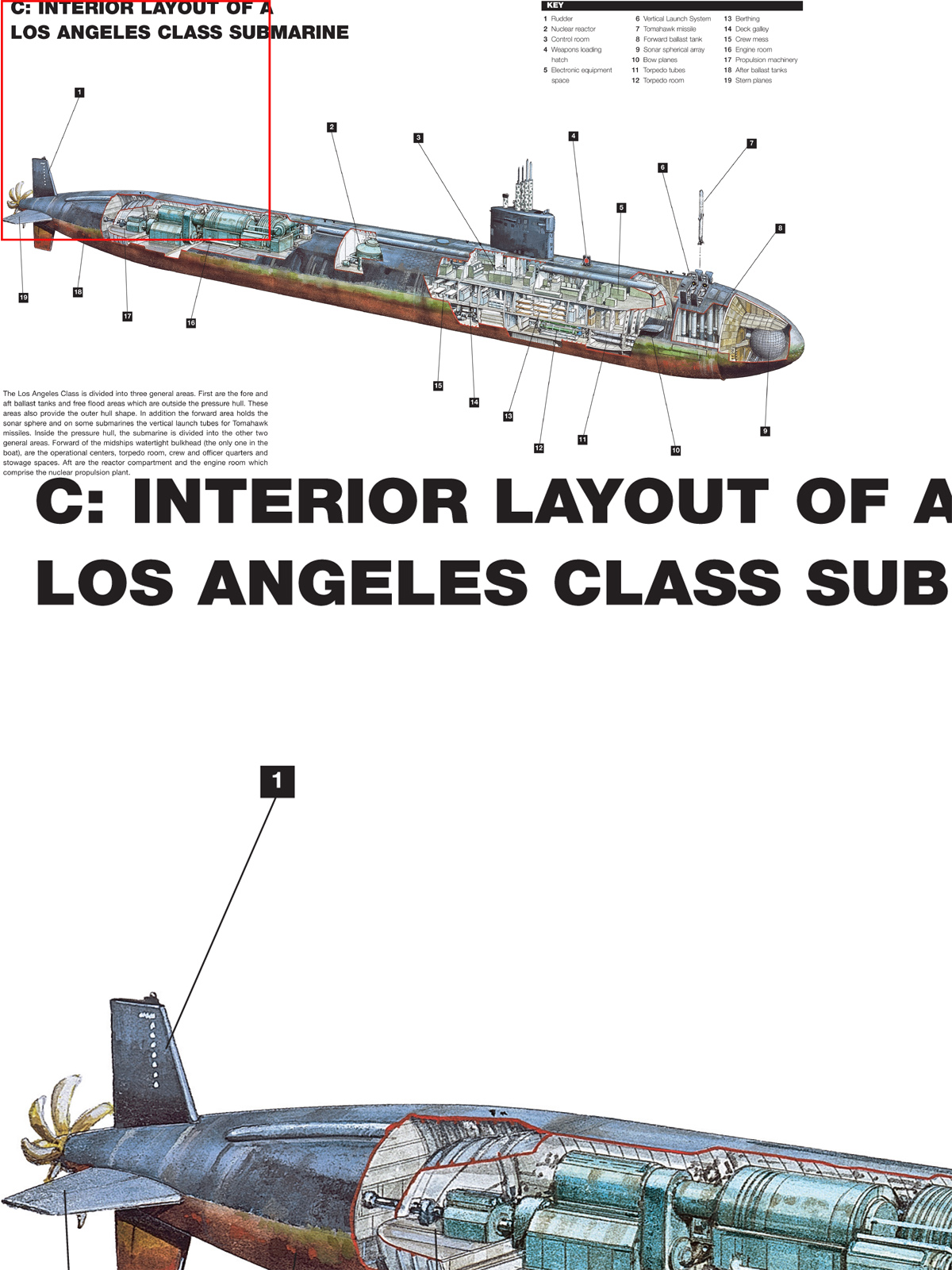

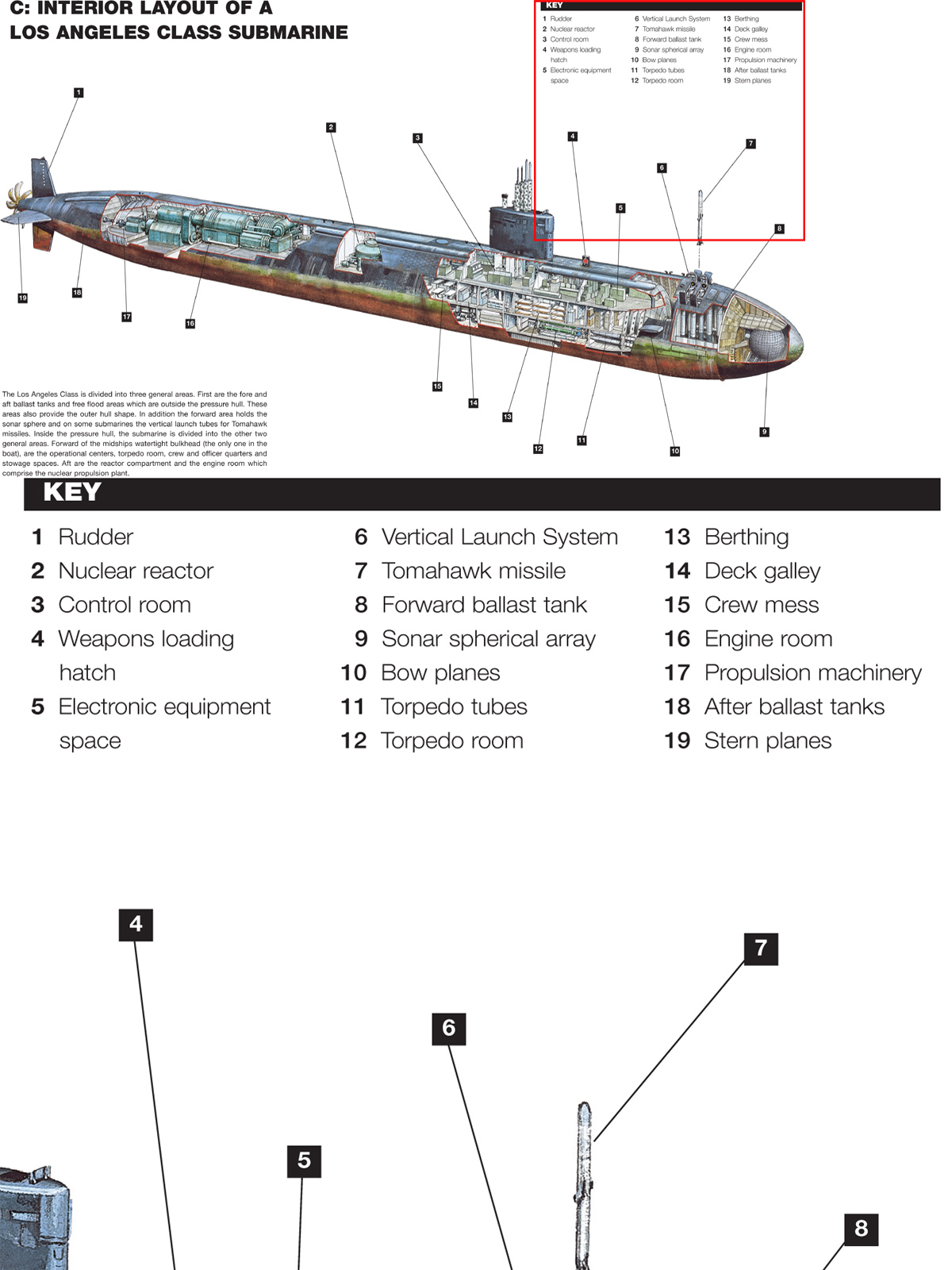
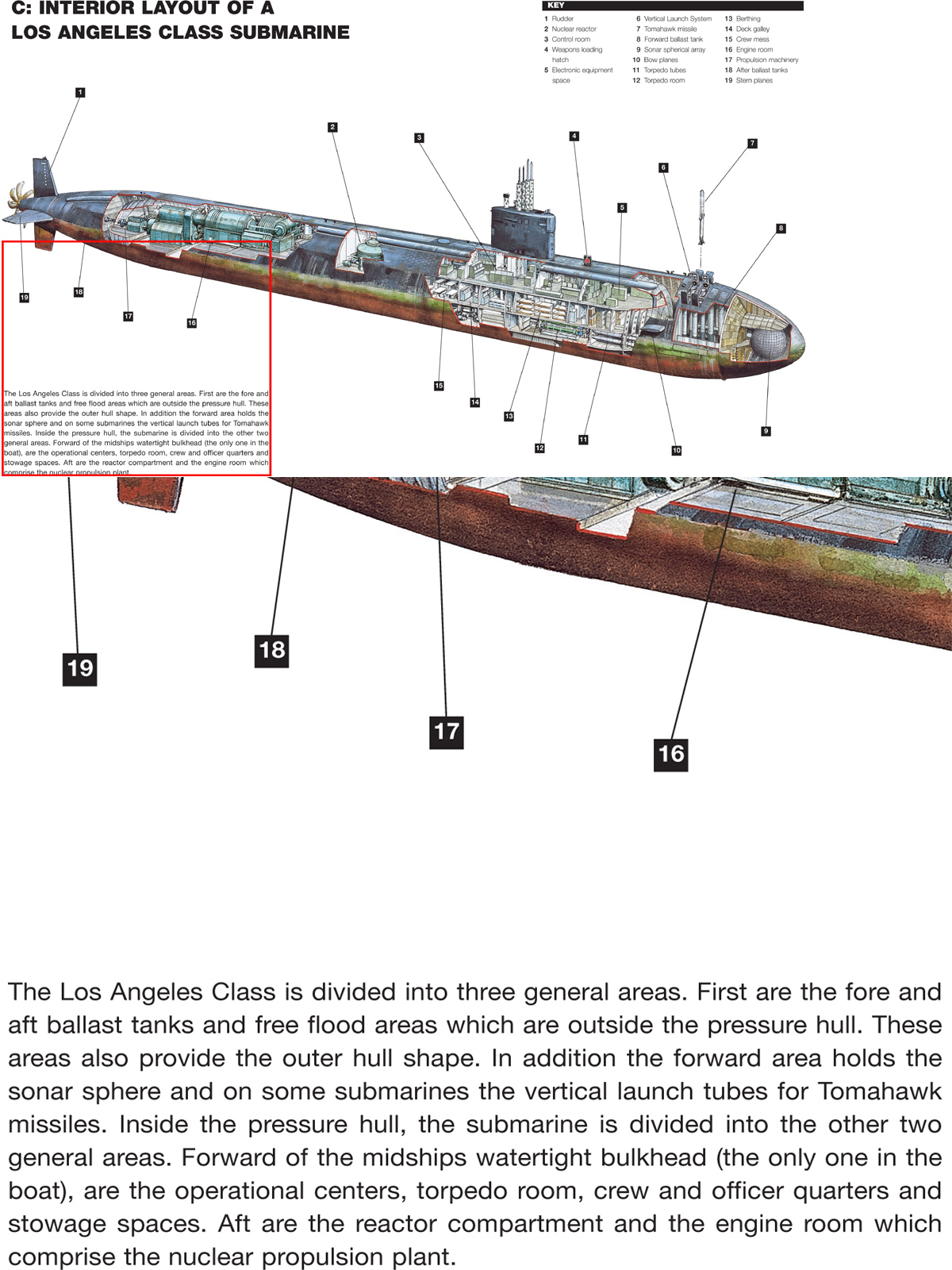
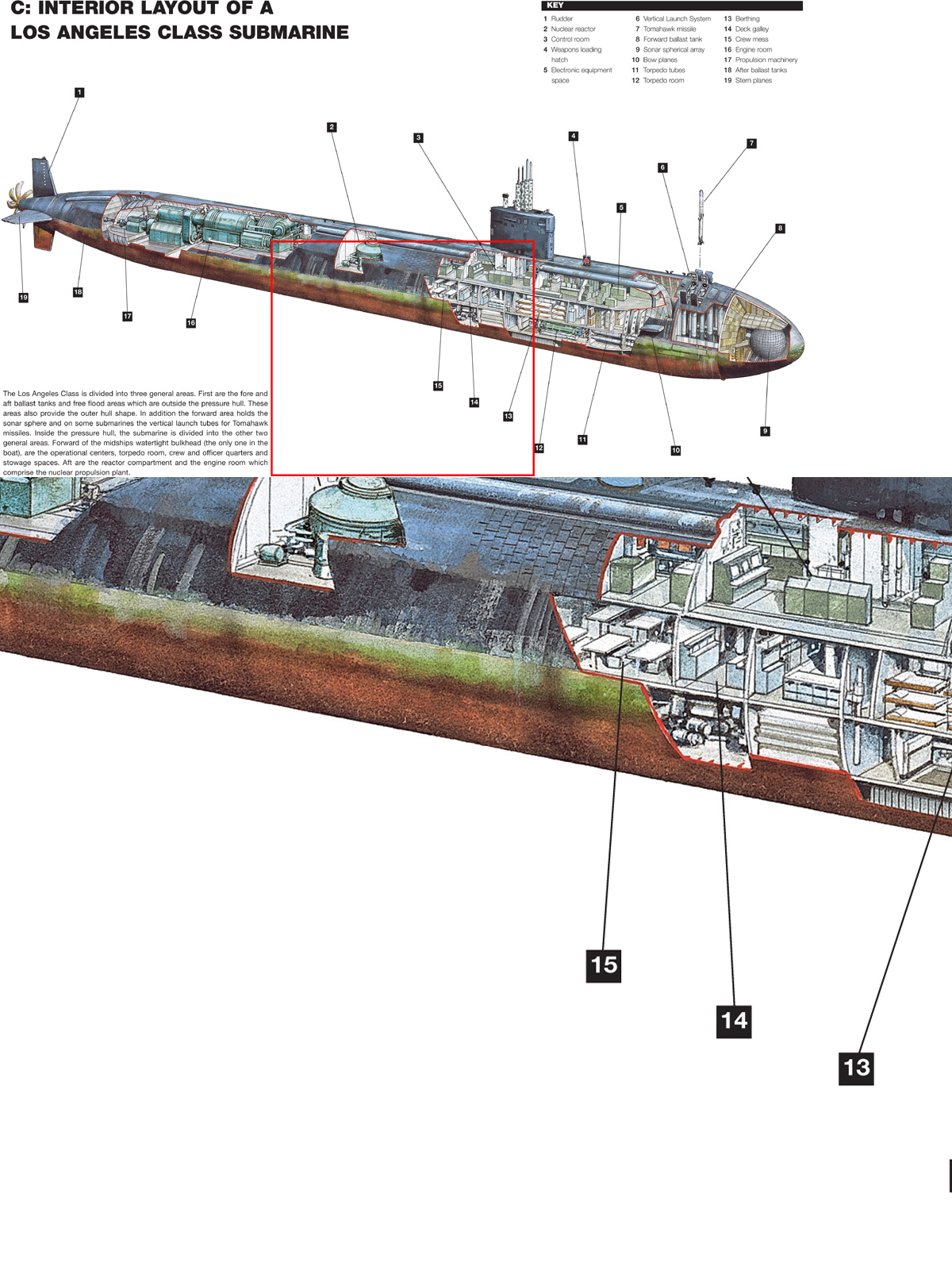

LOS ANGELES CLASS
Class consists 62 ships, USS Los Angeles through USS Cheyenne
Dimensions Length 360ft; beam 33ft
Displacement (surfaced/submerged) 6,000/6,900 tons
Speed (surfaced/submerged) See author’s note
Endurance Only limited by supplies
Design test depth See author’s note
Complement (officer/enlisted) 12/115
Armament Torpedo tubes: four Mk 67 (23ft long by 21in. diameter), angled outward from midships. Bow contains sonar spherical array. The tubes and fire-control systems are capable of handling various types of torpedo (Mk 37-3, Mk 37, Mk 48, Mk 48 ADCAP), SubRoc, Harpoon, and Tomahawk missiles. From SSN-619 on, each submarine had a nest of 12 Vertical Launch System (VLS) tubes for the Tomahawk cruise missile.
Service history:
| Laid down | Launched | Commissioned | Decommissioned | |
| USS Los Angeles (SSN-688) | 8-Jan-72 | 6-Apr-74 | 13-Nov-76 | – |
| USS Baton Rouge (SSN-689) | 18-Nov-72 | 26-Apr-75 | 25-Jun-77 | 13-Jan-95 |
| USS Philadelphia (SSN-690) | 12-Aug-72 | 19-Oct-74 | 25-Jun-77 | – |
| USS Memphis (SSN-691) | 23-Jun-73 | 3-Apr-76 | 21/17/77 | – |
| USS Omaha (SSN-692) | 27-Jan-73 | 21-Feb-76 | 11-Mar-78 | 5-Oct-95 |
| USS Cincinnati (SSN-693) | 6-Apr-74 | 19-Feb-77 | 10-Jun-78 | 10-Jun-78 |
| USS Groton (SSN-694) | 3-Aug-73 | 9-Oct-76 | 8-Jul-78 | 29-Jul-96 |
| USS Birmingham (SSN-695) | 26-Apr-75 | 29-Oct-77 | 16-Dec-78 | 22-Dec-97 |
| USS New York City (SSN-696) | 15-Dec-73 | 18-Jun-77 | 3-Mar-79 | 30-Apr-97 |
| USS Indianapolis (SSN-697) | 19-Oct-74 | 30-Jul-77 | 5-Jan-80 | 22-Dec-98 |
| USS Bremerton (SSN-698) | 8-May-76 | 22-Jul-78 | 28-Mar-81 | – |
| USS Jacksonville (SSN-699) | 21-Feb-76 | 18-Nov-78 | 16-May-81 | – |
| USS Dallas (SSN-700) | 9-Oct-76 | 28-Apr-79 | 18-Jul-81 | – |
| USS La Jolla (SSN-701) | 16-Oct-76 | 11-Aug-79 | 24-Oct-81 | – |
| USS Phoenix (SSN-702) | 30-Jul-77 | 8-Dec-79 | 19-Dec-81 | 29-Jul-98 |
| USS Boston (SSN-703) | 11-Aug-78 | 19-Apr-80 | 30-Jan-82 | 19-Nov-99 |
| USS Baltimore (SSN-704) | 21-May-79 | 13-Dec-80 | 24-Jul-82 | 10-Jul-98 |
| USS City of Corpus Christi (SSN-705) | 4-Sep-79 | 25-Apr-81 | 8-Jan-83 | |
| USS Albequerque (SSN-706) | 27-Dec-79 | 13-Mar-82 | 21-May-83 | – |
| USS Portsmouth (SSN-707) | 8-May-80 | 18-Sep-82 | 1-Oct-83 | 18-Aug-05 |
| USS Minneapolis-St. Paul (SSN-708) | 30-Jan-81 | 19-Mar-83 | 10-Mar-84 | – |
| USS Hyman G. Rickover (SSN-709) | 24-Jul-81 | 27-Aug-83 | 21-Jul-84 | – |
| USS Augusta (SSN-710) | 1-Apr-82 | 21-Jan-84 | 19-Jan-85 | – |
| USS San Francisco (SSN-711) | 26-May-77 | 27-Oct-79 | 24-Apr-81 | – |
| USS Atlanta (SSN-712) | 17-Aug-78 | 16-Aug-80 | 6-Mar-82 | 16-Dec-99 |
| USS Houston (SSN-713) | 29-Jan-79 | 21-Mar-81 | 25-Sep-82 | – |
| USS Norfolk (SSN-714) | 1-Aug-79 | 31-Oct-81 | 21-May-83 | – |
| USS Buffalo (SSN-715) | 25-Jan-80 | 8-May-82 | 5-Nov-83 | – |
| USS Salt Lake City (SSN-716) | 26-Aug-80 | 16-Oct-82 | 12-May-84 | 25-Oct-06 |
| USS Olympia (SSN-717) | 31-Mar-81 | 30-Apr-83 | 17-Nov-83 | – |
| USS Honolulu (SSN-718) | 10-Nov-81 | 24-Sep-83 | 6-Jul-85 | 1-Nov-06 |
| USS Providence (SSN-719) | 14-Oct-82 | 4-Aug-84 | 27-Jul-85 | – |
| USS Pittsburgh (SSN-720) | 15-Apr-83 | 8-Dec-84 | 23-Nov-85 | – |
| USS Chicago (SSN-721) | 5-Jan-83 | 13-Oct-84 | 27-Sep-86 | – |
| USS Key West (SSN-722) | 6-Jul-83 | 20-Jul-85 | 12-Sep-87 | – |
| USS Oklahoma City (SSN-723) | 4-Jan-84 | 2-Nov-85 | 9-Jul-88 | – |
| USS Louisville (SSN-724) | 16-Sep-84 | 14-Dec-85 | 8-Nov-86 | – |
| USS Helena (SSN-725) | 28-Mar-85 | 28-Jun-86 | 11-Jul-87 | – |
| USS Newport News (SSN-750) | 3-Mar-84 | 15-Mar-86 | 3-Jun-89 | – |
| USS San Juan (SSN-751) | 16-Aug-85 | 6-Dec-86 | 6-Aug-88 | – |
| USS Pasadena (SSN-752) | 20-May-86 | 12-Sep-87 | 11-Feb-89 | – |
| USS Albany (SSN-753) | 22-Apr-85 | 13-Jun-87 | 7-Apr-90 | – |
| USS Topeka (SSN-754) | 13-May-86 | 23-Jan-88 | 21-Oct-88 | – |
| USS Miami (SSN-755) | 24-Oct-86 | 12-Nov-88 | 30-Jun-90 | – |
| USS Scranton (SSN-756) | 29-Aug-86 | 3-Jul-89 | 26-Jan-91 | – |
| USS Alexandria (SSN-757) | 19-Jun-87 | 23-Jun-90 | 29-Jun-91 | – |
| USS Ashville (SSN-758) | 9-Jan-87 | 28-Oct-89 | 28-Sep-91 | – |
| USS Jefferson City (SSN-759) | 21-Sep-87 | 17-Aug-90 | 28-Feb-92 | – |
| USS Annapolis (SSN-760) | 15-Jun-88 | 18-May-91 | 11-Apr-92 | – |
| USS Springfield (SSN-761) | 28-Oct-88 | 9-Nov-91 | 4-Dec-92 | – |
| USS Columbus (SSN-762) | 28-Apr-89 | 1-Aug-92 | 24-Jul-93 | – |
| USS Santa Fe (SSN-763) | 25-May-91 | 12-Dec-92 | 8-Jan-94 | – |
| USS Boise (SSN-764) | 25-Aug-88 | 23-Mar-91 | 7-Nov-92 | – |
| USS Montpelier (SSN-765) | 19-May-89 | 23-Aug-91 | 13-Mar-93 | – |
| USS Charlotte (SSN-766) | 7-Jan-90 | 3-Oct-92 | 16-Sep-94 | – |
| USS Hampton (SSN-767) | 2-Mar-90 | 3-Apr-92 | 6-Nov-93 | – |
| USS Hartford (SSN-768) | 27-Apr-92 | 4-Dec-94 | 10-Dec-94 | – |
| USS Toledo (SSN-769) | 8-Apr-91 | 28-Aug-93 | 24-Feb-95 | – |
| USS Tucson (SSN-770) | 20-Sep-91 | 19-Mar-94 | 9-Sep-95 | – |
| USS Columbia (SSN-771) | 9-Feb-93 | 24-Sep-94 | 9-Oct-95 | – |
| USS Greenville (SSN-772) | 16-Apr-92 | 17-Sep-94 | 13-Feb-96 | – |
| USS Cheyenne (SSN-773) | 6-Oct-92 | 1-Apr-95 | 29-Jul-96 | – |
| Those without decommissioning dates are, as of this writing, still in active service. | ||||
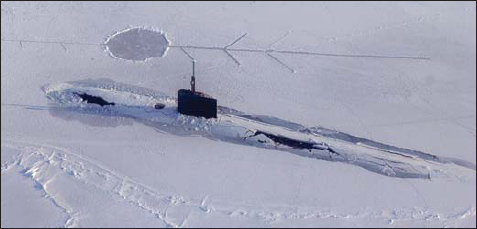
Los Angeles Class fast attack submarine USS Alexandria is submerged after surfacing through two feet of ice during ICEX-07, a US Navy and Royal Navy exercise conducted on and under a drifting ice floe about 180 nautical miles off the north coast of Alaska.
This class was designed and built to counter the threat of the Soviet navy’s new attack submarines, such as the Alfa and Akula. The fight, if it ever took place, would happen in the deep waters well away from land masses, thus the design was for a “blue-water” system. The 30-boat Seawolf Class was planned as a follow-on to the Los Angeles Class. Larger, faster, and quieter than any of the preceding fast attack classes, the Seawolf sported eight 21-in. torpedo tubes, an extensive integrated sonar/fire-control suite (CCS Mk 2), and a redesigned powerplant complete with a shrouded propulsor. Just as the Seawolf was under construction, the Soviet Union came apart and the world changed. The need for an extensive blue-water submarine force was seen as being over, and the 30 ships of the Seawolf force became only three. Given hull numbers out of sequence, SSN-21, -22, and -23, the class became a testing ground for new concepts and new equipment.
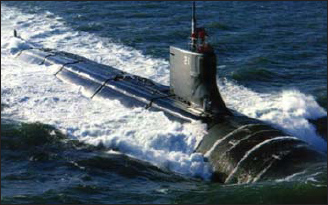
The USS Seawolf (SSN-705) underway on the surface, proceeding out of New London on its first sea trials. Lead ship of what would become a 30-ship class, she exceeded all design expectations but proved to be too large and too expensive for a changing world.

A Seawolf class being prepared to move to the graving dock. After the majority of the submarine is built, it is rolled out of the enclosed construction building and onto a barge that sits in a graving dock. The water is then pumped out of the dock until the barge rests on the bottom. When the boat is ready to launch, the dock and barge are then flooded, and the boat floats free for the first time.
The Seawolf Class exceeded all expectations, albeit at a time when such an expensive and capable boat was considered to be an extravagance by those holding the budgetary purse strings. The upgraded reactor plant and a pumpjet increased the efficiency of the propulsion system. The silencing was also very efficient. These two qualities combined to make the boat very quiet at a high underwater speed. Aside from the USS Seawolf, the USS Connecticut was completed as a standard Seawolf and the third of the class, the USS Jimmy Carter, was extended by nearly 100ft and modified to become a multimission special operations submarine.
SEAWOLF CLASS
Class consists of three ships, USS Seawolf, USS Connecticut, USS Jimmy Carter
Dimensions Length 360ft; beam 40ft; USS Jimmy Carter length 453ft
Displacement (surfaced/submerged) 6,000/6,900 tons
Speed (surfaced/submerged) See author’s note
Endurance Only limited by supplies
Design test depth See author’s note
Complement (officer/enlisted) 12/115
Armament Torpedo tubes: eight torpedo tubes (23ft long by 21in. in diameter). With its exceptionally large torpedo room the boat could carry large numbers of each of the following: Mk 48 ADCAP torpedo, the Harpoon antiship missile, the Tomahawk cruise missile, and Mk 60 CAPTOR (Encapsulated Torpedo) mines.
A search started in the early 1990s for how to keep the Seawolf Class capabilities yet have a less expensive submarine. The United States submarine force was up against several problems. Many, even in the naval community, saw no further use for a large number of submarines. The Sturgeon Class and early Los Angeles Class boats were reaching the end of their useful lives and hard choices had to be made whether to upgrade these boats in expensive yard overhauls or to decommission hem. The Navy chose the latter. The submarine force was dropping rapidly from a high of nearly 120 submarines toward a number nearer 50, a figure that included the 16 Ohio Class ballistic missile submarines. A new design was undertaken that resulted in a significant change in the way submarines in the US Navy were built and operated.
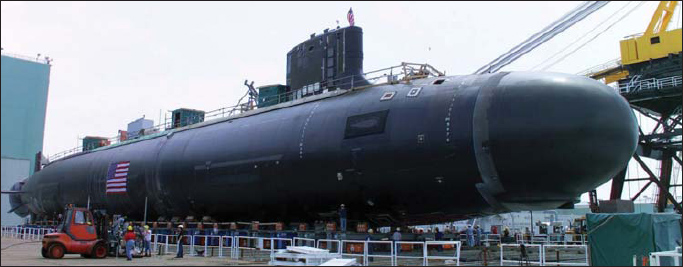
A Virginia Class in the construction building at Newport News. The tarp covers protect the fiberglass sonar dome that comprises the bow of the sub. Note the opening in the front of the sail. This houses the upward-looking sonar receiver.
Two of the driving forces behind this change were the continuing advances in computer technology and the need to reduce the crew of a submarine. Computers were getting better, smaller, and more reliable. A versatile computer network was to be center of the new submarine’s electronics design. An outgrowth of this concept was that the submarine’s control technology was redesigned as a “fly by wire” computer-assisted system. This system reduced the number of crew actively participating in the helm, planes, ballasting, and trim of the boat, and hence the ship control party was reduced from six to three. Given that the submarine normally operated in a three-watch section daily rotation, the savings in personnel from this change was nine sailors in the crew. This new submarine was to become the Virginia Class.
The first ship of the class marked a new generation of submarine design, construction, and operation. Its sea trials were extraordinary in that, for the first time, there were no major deficiencies noted for correction. The entire vessel was designed using extensive computer visualization and advanced computer aided design (CAD). Seawolf Class had led the way in this new design and build system, but the Virginia Class proved that the system worked on a large scale. The construction method achieved significant savings in cost and manning, and the advanced engineering of the reactor plant meant a great efficiency in fuel loading and use. These submarines will never have to be refueled – the reactor core will last the life of the ship.
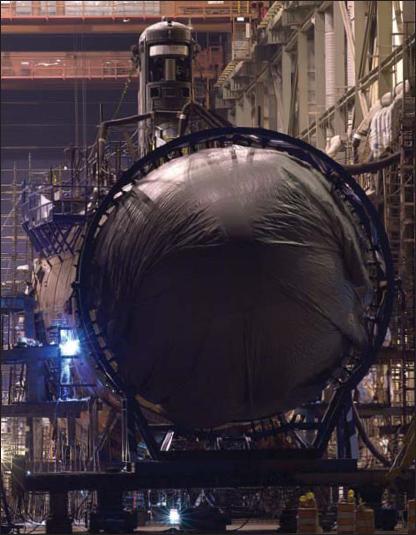
USS Virginia moved out of doors at Groton, Connecticut, August 5, 2003 for the first time in preparation for her christening. Note the bulk of the ship, like an iceberg, is mostly underwater.
Today the US fast attack submarine fleet consists of the Los Angeles Class, which is being replaced by Virginia Class boats as the former reach their end of their useful lives, and two Seawolf Class (the USS Jimmy Carter being a special operations boat). The force is more versatile and more capable than ever. They are “always there, never seen.”
VIRGINIA CLASS
Class is to consist of 30 ships, and the hull numbers start with SSN-774 and will proceed to SSN-804.
Dimensions Length 377ft; beam 34ft
Displacement (surfaced/submerged) 6,800/7,300 tons
Speed (surfaced/submerged) See author’s note
Endurance Only limited by supplies
Design test depth See author’s note
Complement (officer/enlisted) 12/115
Armament Weapons suite consists of 12 VLS tubes and four 21-in. torpedo tubes with the capacity for 16 Tomahawk missiles and up to 26 Mk 48 ADCAP torpedoes. The ship is also equipped to carry the Harpoon antiship missile and Mk 60 CAPTOR mines. There is an integral lockout chamber that can host the SEAL Delivery System and SEAL teams for special operations. Sensor and weapons control is via the Command and Control Systems Module (CCSM), which consists of an open architecture grouping of common display and control modules and a modification of the CCS Mk 2 combat system.
Electronic countermeasures include the WLY-1 acoustic countermeasure and the BLQ-10 electronic surveillance system. The sonar system for the Virginia Class consists of the BQQ-10 active and passive spherical array with the low-frequency conformal array in the bow dome. The ship is also fitted with the thick line towed array (TB-29), the thin line towed array, and a wide aperture flank array.
Service history (at time of writing):
| Laid down | Launched | Commissioned | |
| USS Virginia (SSN-774) | Sep-99 | Aug-03 | Oct-04 |
| USS Texas (SSN-775) | Jul-02 | Apr-05 | Sep-06 |
| USS Hawaii (SSN-776) | Aug-04 | Jun-06 | – |
| USS New Hampshire (SSN-777) | May-04 | – | – |
| USS New Mexico (SSN-778) | – | – | – |
PLATE D
The most modern of the US nuclear fast attack submarines continue the hull form which provides most efficient underwater performance within the constraints of the engineering, habitability, weapons and sensor requirements. Small changes in the outer form can be seen in these three classes. In the Los Angeles Class (1) the sail (fin) is farther aft than is optimal due to the requirement to have the periscopes penetrate directly through the hull to the control room. Electronic-optical (optronic) periscopes which don’t use the long optical tube hull penetration have since enabled designers to place the sail (fin) where it will give the most optimal hydrodynamic performance rather than having to be directly over the control room. The Seawolf class (2) was to be a large quiet “blue water” attack submarine to counter the perceived Soviet deep diving fast submarine threat. The open specially shaped screw has given way to the more efficient shrouded propulsor. Seen at the bottom is the Virginia Class (3), which combines the need for a quiet high-speed submarine with the versatility required by today’s global military picture.
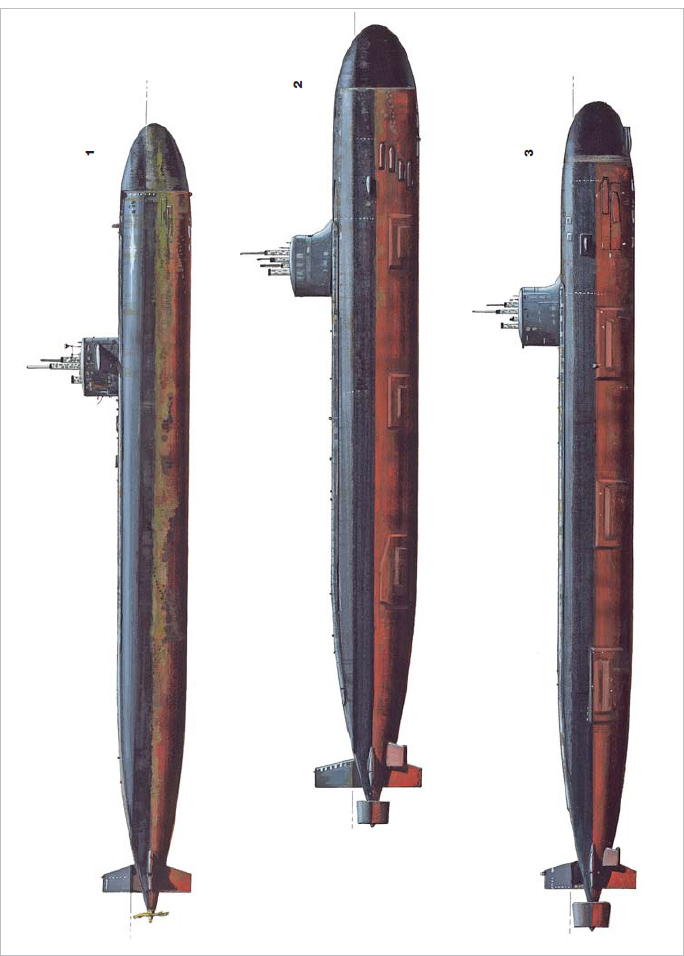
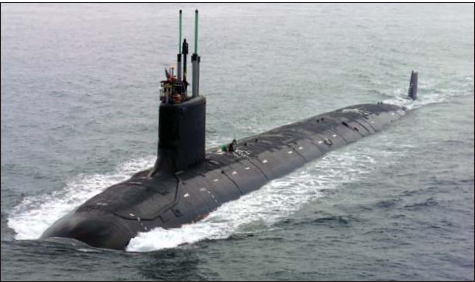
A Virginia Class underway on trials. Extending from the top of the sail are two BRA-34 antennae, a snorkel mast, and a multipurpose ESM antenna. Aft of the sail is the open hatch to the operations compartment, with the man handing down the last of the items topside. He will then drop down and seal the hatch, completing the topside “Rig for Dive.”